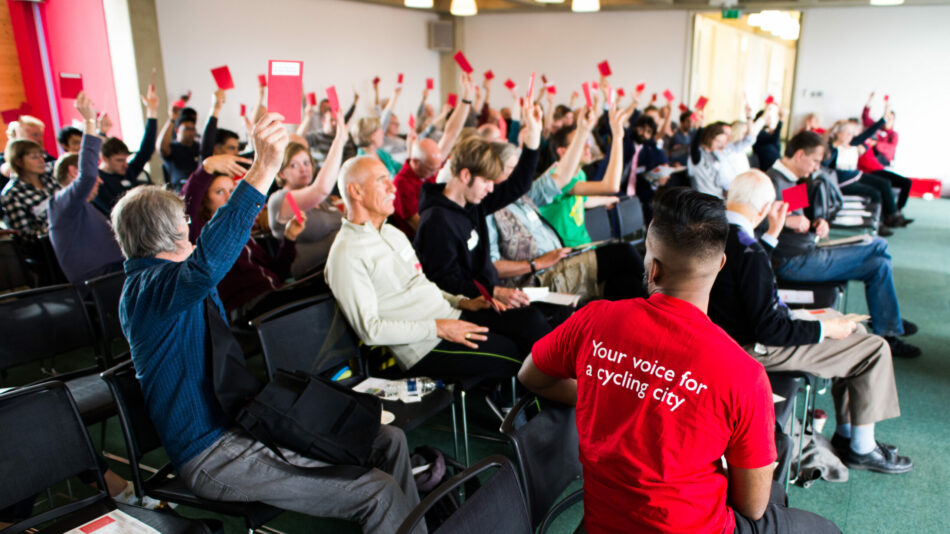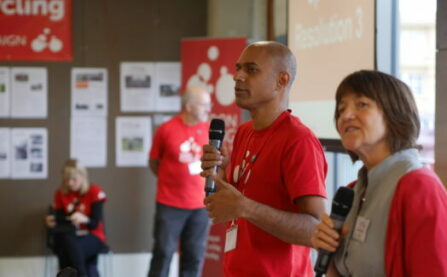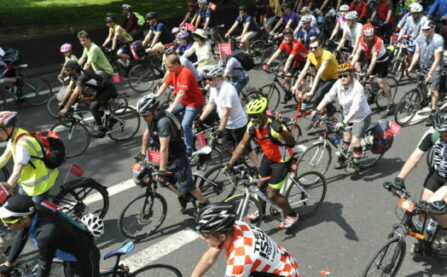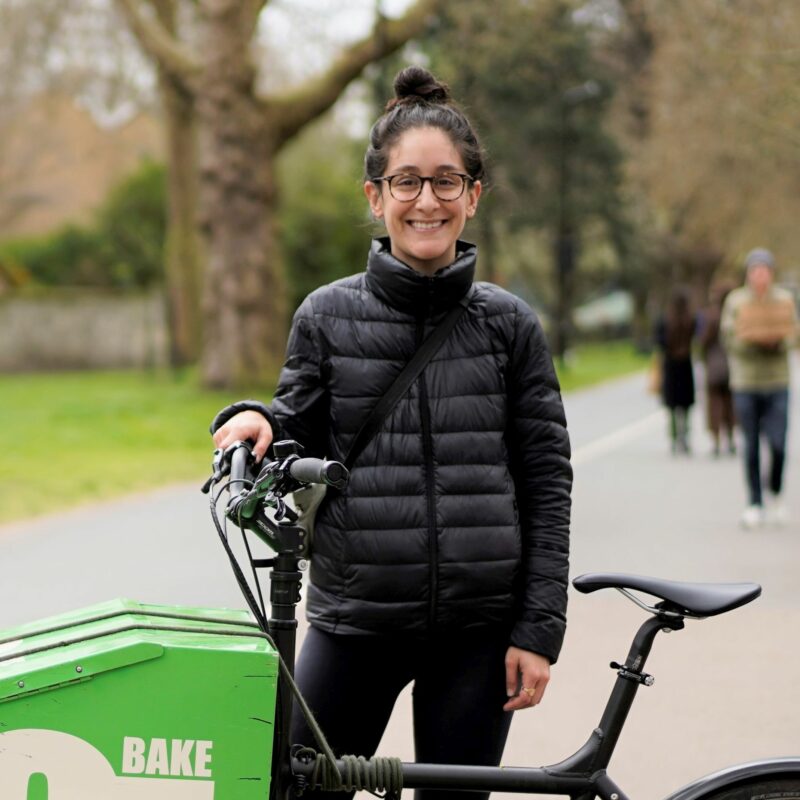

LCC’s AGMs are held at the end of each year. It is both LCC’s highest decision-making body and where trustees are elected. Members are invited to stand as trustees and submit motions for debate and voting. In line with LCC’s AGM Standing Orders all motions will be subject to a process of scrutiny and possible amendment prior to the AGM. For full details, please refer to the Standing Orders.
For queries or to submit motions, please email agm@lcc.org.uk
Previous Annual Accounts
Audited Accounts and Trustees’ Report 2022-2023
Audited Accounts and Trustees’ Report 2021-2022
Audited Accounts and Trustees’ Report 2020-2021
Audited Accounts and Trustees’ Report 2019-2020
Audited Accounts and Trustees’ Report 2018-2019
Audited Accounts and Trustees’ Report 2017-2018
Audited Accounts and Trustees’ Report 2016-2017
Audited Accounts and Trustees’ Report 2015-2016
Audited Accounts and Trustees’ Report 2014-2015
Previous AGM minutes
Previous AGM Resolutions
Each year at the AGM our members get the opportunity to shape the direction of LCC’s activities over the forthcoming year.
A list of motions from past AGMs can be found below.
Policy on One Way Streets
Noting that the LCC Policy Forum agreed a document (http://lcc.org.uk/uploads/9508) on one-way streets on 29 July 2015 that stated:
1. Two-way cycling should be the default on London’s streets; and
2. The question of whether streets should be two-way or one-way for motor vehicles should be decided on a case-by-case basis,
LCC now resolves that:
1. We will support schemes that restrict motor vehicle flow to one direction to allow the creation of high quality Space for Cycling, and will support one-way schemes that are designed to remove through-traffic, provided speed limits are 20mph (or lower) and adequate attention is given to quality of the pedestrian environment.
2. If there are conversions from one-way to two-way working of roads carrying more than 2000 PCU per day, we will demand that each pair of parallel roads should, between them, provide protected Space for Cycling in both directions.
3. We will press for the improvement of existing one-way systems via speed reduction measures, introduction of two-way cycling and improvement of pedestrian crossing facilities.
Presumed Liability
We believe that the number of fatalities and injuries to London cyclists is unacceptably high. Currently, those injured, or the families of those killed, go through an often harsh and protracted process to gain much needed treatment, care, or compensation.
We note that versions of a Presumed Liability rule exist in the civil law of most European countries. Apart from the UK the other exceptions are Ireland, Malta, Romania and Cyprus.
Presumed Liability means that in civil actions after a collision with a cyclist or pedestrian, the motorist would be presumed to be at fault, unless they could prove that they were not to blame. It would not mean the motorist was criminally liable: it would just be for the purposes of compensation.
Presumed Liability would deliver fairer and faster justice for injured vulnerable road users.
We call on the London Cycling Campaign to campaign for Presumed Liability to be incorporated into law, and to work with other organisations involved in campaigning for Presumed Liability.
Buses and Bicycles
LCC notes:
Policies passed at the 2013 AGM say we need inclusive cycling environments on a dense and direct core cycle network. Policy includes a test for when we think protected space is needed: where speeds are over 20mph, or daily motor traffic volumes over 2,000 Passenger Car Units.
LCC’s Policy Forum has been discussing bus-bicycle interaction, triggered by concerns that creating space for cycling will cause problems for buses.
LCC resolves:
1. Where the core cycle network coincides with a bus route, usually the ‘protected space’ test will mean we need to separate bicycles from buses, at route level or at street level.
2. Separation at route level can mean re-routing buses (for example, to create a cycle-only street, as in The Narroway, Hackney), or re-routing the core cycle network. If the second option is chosen, this must maintain network density and directness, and access to key destinations.
3. Where buses and bicycles are separated at street level, we want high quality cycle tracks or protected lanes, which cater for the increases in cycling they will generate. Protected space must continue safely through junctions and past bus stops.
4. We do not believe this stance creates conflict between bus and bike provision. The current situation has put cyclists at risk: buses seriously injure as many cyclists in London as lorries do. Mixing high bus and bicycle flows delays both, although this is not taken into account in modelling.
5. Separating bicycles from buses has important wider benefits. It will create safer, more pleasant cycling environments, encouraging more bus users to cycle some short trips, with big health gains. This can reduce overcrowding on buses and create capacity to shift other trips from car to bus.
6. Planners should not assume creating space for cycling threatens buses. It should be considered an opportunity to prioritise both buses and bicycles over less efficient modes.
Buses and Modal Share in Central London
Noting:
1. The history of cycling campaigners supporting provision for buses as beneficial for walking and cycling (by reducing demand for private car use).
2. Figures published by the Greater London Authority showing that buses now cause more cycling KSIs per km travelled than HGVs. Reference: “News from Darren Johnson AM: Buses as dangerous as lorries for cyclists, but not as fatal”, 11 April 2014, https://www.london.gov.uk/media/assembly-member-pressreleases/green-party/2014/04/news-from-darren-johnson-am-buses-as-dangerous-as-lorries-for.
3. Figures published by the Greater London Authority in the Mayor’s Air Quality Strategy (December 2010) showing that buses are a significant, and growing (as a percentage of total particulates) source of air pollution in Central London.
4. Recent road schemes in Central London, such as Camden’s proposed West End Project have sought to justify inadequate provision for cycling on the need to improve or maintain provision for buses and existing bus and cycling modal share.
Defining ‘Central London’ as the area within the “Inner Ring Road”, LCC resolves to:
1. No longer automatically assume that increasing, or even maintaining, provision for buses in Central London is beneficial for walking or cycling. Nor to automatically accept that such provision for buses is a legitimate reason to accept poor provision for cycling.
2. Campaign for TfL and London boroughs, in every Central London road scheme, to actively consider opportunities for modal shift from buses to cycling, through the provision of high quality ‘Space for Cycling’. Highway authorities should design cycling provision for the modal share likely when there is high quality provision, not based on current modal share, which is suppressed by poor provision.
3. Seek integration of tube and bus fares (including daily Oyster / Contactless price-capping and Travelcards) with TfL Cycle Hire so as to eliminate the financial incentive that commuters have in choosing to get a bus over hiring a cycle for the final part of their journeys into Central London.
Uniformity of cycling provision and suitability for all ability groups
LCC welcomes the Mayor’s plans for the Cycle Superhighways, Quietways and the Central London Grid. However, it considers that the standard of all links in the overall planned cycle network for London must be uniform, in the sense that there must be equal suitability, usability, and level of safety, of all the facilities, for all cyclists who might use them. We consider it would be a mistake for the standards for any elements of the network, for example, the Superhighways or Quietways, to be specified in a way that makes them less suitable, for example, for use by children, or by inexperienced cyclists, families, and the disabled. The corollary of this is that network elements must not be such as to involve a trade-off between safety and convenience; in other words, cyclists wanting the safest journey should not be forced to use a less convenient or slower route, or a route having lower priority, because the most convenient, fastest, or most prioritised route is engineered to a lower safety standard.
When Do We Need Protected Space for Cycling?
We welcomed the Mayor’s Vision for Cycling, and expect its aspirations to be put into practice. Superhighways, Quietways, Mini-Hollands and other transport or streetscape schemes that promise cycling improvements must enable mass cycling. See for more detail the Policy Forum document ‘When Do We Need Protected Space for Cycling?’
LCC resolves:
1. We believe ‘safe and inviting’ cycling environments do not compel cyclists to share space with high speed or high volume motor traffic.
2. Cyclists should not be expected to share space with motor vehicles moving above 20mph.
3. If cyclists will share space with motor traffic, volumes must be low. On the core cycle route network this should not exceed the Dutch maximum for main cycle routes, 2,000 Passenger Car Units per day.
4. In assessing schemes where current motor traffic speeds or volumes are too high we will expect to see either (i) specific measures to reduce both motor traffic volumes and speeds to levels acceptable for sharing or (ii) high quality protected cycle infrastructure.
5. Where schemes are inadequate, and depending on context (e.g. residential streets vs. main roads) we will push for high quality protected cycle infrastructure and/or measures to reduce both motor traffic volumes and speeds to levels acceptable for sharing.
Please refer to the full text of the Policy Forum document When Do We Need Protected Space for Cycling, 9th August 2013.
LCC Policy on use of cycling facilities
The LCC notes an increase in the number and diversity of people cycling on an increasingly wide range of cycles. The LCC believes that people should have the right to make an informed judgment whether to use cycle facilities or the (rest of the) carriageway. It therefore opposes any attempt, whether through the legal system or otherwise, to compel people when cycling to use cycle facilities.
LCC Policy on standard of cycling facilities
The LCC further believes that substandard cycle facilities can be worse than no facility at all and that the lack of minimum standards is leading to poor quality facilities, some of which are so bad that they are unsuitable for cycling in at all, besides increasing tensions with other roads users who may not understand why people do not wish to cycle in them.
Policy Resolution of the 1998 AGM
The LCC will promote shared use:
1. Where it will enable cyclists to have access to parks, canalside and riverside routes and other recreational routes
2. Where it will enable cyclists to have access to pedestrianised areas
3. To enable and encourage cycling by children, people with disabilities and/or inexperienced cyclists
4. To discourage use of motor vehicles and encourage a modal shift towards pedestrians and cyclists
5. As part of the reallocation of roadspace from motor vehicles towards pedestrians and cyclists
6. When it is properly designed in accordance with the design principles forming part of this policy
The LCC will oppose shared use:
1. Where it is intended to replace or be a substitute for effective on-road cycling facilities
2. Where it will reduce the total area of roadspace available to cyclists and pedestrians
3. As a part of the LCN or other strategic cycling routes
4. Where the benefit to cyclists will be outweighed by the legitimate concerns of pedestrians
5. Where its use would be dangerous to cyclists or pedestrians
6. When it is not properly designed in accordance with the design principles forming part of this policy
Definitions
For the purposes of this policy:
“Shared use” means that the use of part of the roadspace is shared between cyclists and pedestrians
“Roadspace” is the whole of a highway including road and pavement
“Road” is the part of the roadspace designated for vehicles
“Pavement” is the part of the roadspace designated for pedestrians
“Pedestrians” include people walking, children in prams or buggies, rollerskaters and people using wheelchairs
Design principles
1. There should be consultation with the LCC and other user groups.
2. The legitimate concerns of vulnerable users (such as parents of young children and people with visual disabilities) should be taken into account.
3. Shared use should be open to all cyclists, including riders of side-by-side cycles, tandems, children’s cycles, “Duet” and similar specialised cycles, and cycles with panniers or children seats.
4. Access controls or barriers should only be used where essential, must not exclude any cyclists, and should not require any cyclist to dismount or lift their cycle over any obstruction.
5. Shared use should not be open to motorised vehicles of any kind, except emergency vehicles (in emergencies) and powered wheelchairs.
6. There should no charge for using shared use facilities.
7. Priorities between pedestrians and cyclists should be made clear by signs or otherwise.
8. Cyclists should only be expected to give priority to other cyclists or to pedestrians.
9. Cyclists should not be required to stop or dismount, except to give priority to other cyclists or to pedestrians.
10. Segregation of cyclists from pedestrians should be used where necessary and should be clear to all users.
11. High kerbs and other hazards to cyclists should be avoided. Where hazards are unavoidable, appropriate warning signs or markings should be provided.
The following policies have been adopted by the London Cycling Campaign as a result of decisions by the Board or by its subcommittees; following a Board resolution these policies, like AGM resolutions, are also binding on the LCC as a whole, including local groups, representatives and Trustees when speaking on behalf of the LCC.
Space for Cycling
Agreed by the Policy Forum at 29th January and 26th March 2014 meetings, and accepted by the Campaigns & Active Membership subcommittee and the Board as the policy basis for the Space for Cycling campaign.
Go Dutch Key Principles
Approved by the Campaign & Active Membership Subcommittee (confirmed by C&AM Chair’s Action on 26th October 2011).
No More Lethal Lorries
Approved by the Campaigns Focus Committee (now the C&AM), at its 16th June and 14th September 2010 meetings.
Beat the Thief
Approved by the Campaigns Focus Committee (now C&AM), at its 16th January and 5th May 2010 meetings.
Find out more

How we're run
Member-led and with a dedicated staff team and Board of Trustees. Find out more about how we operate here.
Find out more

Our Local Groups
LCC has a group of active members in every London borough - they campaign for local cycling improvements and also run rides and events.
Find out more

Join LCC
LCC is only effective because it's supported by more than 10,000 members. If you cycle in London please consider joining - help make LCC's work possible and get some fantastic benefits too...
Find out more
Keep up to date
